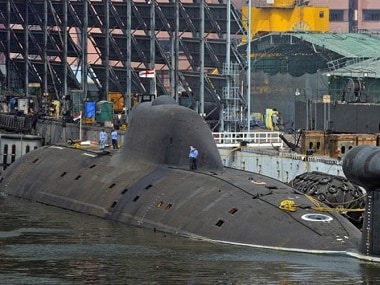India's indigenously-constructed nuclear submarine INS Arihant, which was quietly commissioned into service in 2016, has reportedly suffered major damage and has not sailed for months. According to details available with The Hindu, Arihant's propulsion compartment suffered damage after water entered the area over ten months ago because of possible human error.

File image of INS Arihant. News18
The sources further quoted in the report said that since the accident, the submarine has been undergoing repairs and has not sailed. The absence of INS Arihant came to attention during the Doka La standoff with China because during such standoffs, countries carry out precautionary advance deployment of submarine assets, The Hindu report added.
The submarine was launched in 2009 by then Prime Minister Manmohan Singh and was formally commissioned by Navy Chief Admiral Sunil Lamba. With its commission, India had 'quietly' completed its nuclear triad.
A nuclear triad gives a country the ability to launch nukes from land, air and sea. Arihant is the most important platform in India's triad and would have helped India achieve the capability of going into high seas without the need to surface the vessel for a long duration.
INS Arihant is a 6,000-ton SSBN (ship submersible ballistic, nuclear submarine) that can carry ballistic missiles with nuclear warheads. SSBNs are equipped with better stealth features and are larger compared to SSNs, which are nuclear-powered attack submarines. The SSBNs are the best bet when it comes to a retaliatory strike to a nuclear attack.
INS Arihant is propelled by an 83 MW pressurised light-water reactor at its core which was developed following extensive help by the Russians. Moscow helped scientists at the Bhabha Atomic Research Centre (BARC) in miniaturising the reactor to fit into the 10-metre-wide hull of the nuclear submarine. India's quest for its indigenous nuclear submarine began in the late 1990s under top-secret project called Advanced Technology Vessel (ATV).
The plan was to build three such submarines. In 2009, Arihant was launched into the water at the ship-building centre in Visakhapatnam.
Arihant is integrated with "K" (named after former president APJ Abdul Kalam) series of missiles. While the K-15 has a 750-kilometre range, the K-4 can go up to 3,500-kilometre. The K-5 has a much higher range. However, it is not confirmed whether the full integration of missiles have taken place or not.
The design of Arihant is based on the Russian Akula-1 class submarines, of which the best-known example is the INS Chakra.
Chakra, according to a PTI report, had also suffered damage to its solar domes, Lamba said in December last year. He added that a board of inquiry has been set up to look into the damage.
With inputs from agencies
Published Date: Jan 08, 2018 13:33 PM | Updated Date: Jan 08, 2018 13:33 PM
















